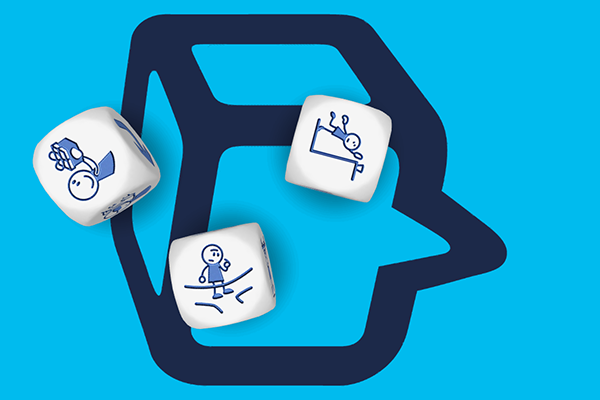Inspiration sometimes comes from unlikely places. Last weekend, I took my children to the Story Museum in Oxford for a reading of The BFG (by the amazing stage actor Anthony Pedley). Anyone with children will know what happens after any such event: there is an obligatory trip to the gift shop. Annoyingly, most gift shops stock the same generic ‘tat’: museum branded stationery and keyrings, elasticated bugs, soft toys, etc. The Story Museum’s gift shop is unique in that it actually sells an array of merchandise related to story telling.
Like most children, my kids love making up stories. It’s not rare for my eldest daughter to churn out a multi-page narrative before breakfast and I’m happy to encourage her creativity. But I also know that this creativity often gets subjugated as we grow into adults. So, on the false premise of treating the kids, I started searching the shop for tools that might help teams unearth more creative approaches to their work?
I found two ideas that I’m going to try out. The first uses Rory’s Story Cubes. The premise is pretty simple: a pack of 9 dice have various designs printed on them. You roll the dice, then use the images on the upturned faces to build a narrative. Now, I’m not saying that a story about a boy climbing a tree (in order to launch his rocket to the moon so that he could grow space bananas) is going to benefit your project scope session. But what about if we asked you:
- If I gave you a present at the start of this project, what would you hope was inside? What would make this project better?
- What might make our project crash land?
- What is going to make our project get a result quicker?
- What question do you wish you had asked before this meeting?
- What is going to be a rude awakening if it happens this Sprint?
- What is the first difficult decision we are going to have to make?
- What is going to be a real stretch for us or will be just out of our reach?
Maybe the dice could permit us to ask questions that we might find uncomfortable asking otherwise? Maybe the dice could help us find a different angle that pushes our minds?

The second idea is based on The Usborne Write Your Own Story Book. This book tries to get children to think of different stories in a variety of ways (such as tell the story of Cinderella but from the perspective of the evil stepmother). Could such ideas help us to think about our users’ needs from an original perspective? Could they help us to think of new product opportunities or risks? I think we could tailor some of their suggestions for our teams:
- Write a user story from the perspective of an unhappy customer or someone who doesn’t want to use our product but has been told they have to?
- Tell a story around a picture , photo or unusual object (such as photos of typical customers at work and figure out what they would benefit from us giving them)
- Tell a story but imagine that you have travelled through time (backwards or forwards)
- Imagine that a customer has just inherited a lot of money from a long-lost uncle: what would this customer want us to supply them?
- Imagine that you have a super power (e.g. you can already do whatever it is that your product is trying to solve), are a hero (e.g. you have saved hundreds of customers with the need you are trying to resolve), villain (e.g. a competitor?) or unusual character (e.g. a customer who lives 5 minutes in the future)
- Use sayings or proverbs as the inspiration for a story (e.g. ‘pigs might fly’) or maybe base your story on an overheard conversation (e.g. “you wouldn’t believe what my best friend said he could do …”).
Are the cubes and Usborne book aimed at kids? Yes. Can they help us think in different ways and improve our creativity? I think so.
Have you used novel ways to draw out unique needs? Tell us …

Hi David,
Rory here. You’ve got some great uses for Rory’s Story Cubes® there. You might be interested to know that Rory’s Story Cubes® started life as a story-based coaching tool. It was inspired by the work of Dr. Win Wenger, Guy Claxton and Andrew Hahn Psy.D.